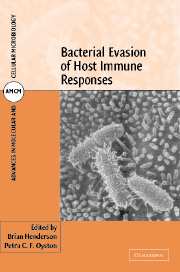Book contents
- Frontmatter
- Contents
- Contributors
- Preface
- Part I Recognition of bacteria
- Part II Evasion of humoral immunity
- Part III Evasion of cellular immunity
- 7 Type III secretion and resistance to phagocytosis
- 8 Bacterial superantigens and immune evasion
- 9 Bacterial quorum sensing signalling molecules as immune modulators
- 10 Microbial modulation of cytokine networks
- 11 Enterotoxins: Adjuvants and immune inhibitors
- 12 Type III protein secretion and inhibition of NF-κB
- Index
- Plate section
- References
9 - Bacterial quorum sensing signalling molecules as immune modulators
from Part III - Evasion of cellular immunity
Published online by Cambridge University Press: 13 August 2009
- Frontmatter
- Contents
- Contributors
- Preface
- Part I Recognition of bacteria
- Part II Evasion of humoral immunity
- Part III Evasion of cellular immunity
- 7 Type III secretion and resistance to phagocytosis
- 8 Bacterial superantigens and immune evasion
- 9 Bacterial quorum sensing signalling molecules as immune modulators
- 10 Microbial modulation of cytokine networks
- 11 Enterotoxins: Adjuvants and immune inhibitors
- 12 Type III protein secretion and inhibition of NF-κB
- Index
- Plate section
- References
Summary
INTRODUCTION
For many pathogens, the outcome of the interaction between host and bacterium is strongly influenced by bacterial population size. Coupling the production of virulence determinants with cell population density ensures that the host lacks sufficient time to mount an effective defence against consolidated attack. Such a strategy depends on the ability of an individual bacterial cell to sense other members of the same species and, in response, differentially express specific sets of genes. Such bacterial cell-to-cell communication or “quorum sensing” describes the phenomenon whereby the accumulation of a diffusible, low molecular weight signal molecule (sometimes referred to as a “pheromone” or “autoinducer”) enables individual bacterial cells to sense when the minimal population unit or “quorum” of bacteria has been achieved for a concerted population response to be initiated. Quorum sensing thus constitutes a mechanism for multicellular behaviour in prokaryotes and is now known to control many different aspects of bacterial physiology including the production of virulence determinants in animal, fish, and plant pathogens. A number of chemically distinct quorum sensing signal molecules (QSMs) have been described of which the N-acylhomoserine lactone (AHL) family in Gram-negative bacteria has been the most intensively investigated (for reviews see Salmond et al., 1995; Fuqua et al., 1996; Dunny and Winans, 1999; Williams et al., 2000; Withers et al., 2001). The acyl groups of the naturally occurring AHLs identified to date range from 4 to 14 carbons in length and may be saturated or unsaturated with or without a C3 substituent (usually hydroxy or oxo; see Fig. 9.1).
- Type
- Chapter
- Information
- Bacterial Evasion of Host Immune Responses , pp. 201 - 222Publisher: Cambridge University PressPrint publication year: 2003
References
- 2
- Cited by

